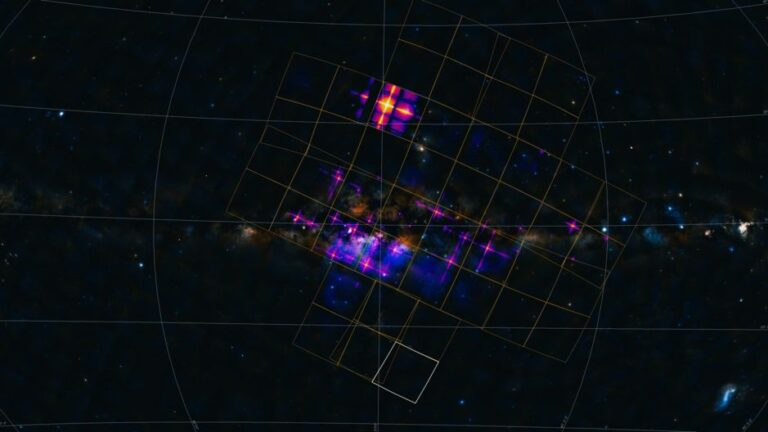A joint China-European X-ray telescope mission called the Einstein probe has succeeded in observing the universe in a wide screen with a telescope design that mimics a lobster’s eye.
The Einstein spacecraft, launched on January 9 on a Chinese Long March rocket, is currently orbiting Earth at an altitude of 600 kilometers (373 miles), conducting tests and calibrating its instruments. The first observations were made at a symposium in Beijing.
The problem with X-rays is that their energy is so high that they are difficult to capture with standard detectors. The lens does not work because the X-rays are too powerful to be easily refracted. Also, his X-rays that hit the mirror head-on simply pass through the mirror. Rather, detection of X-rays is only possible when the X-rays strike a reflective surface at a shallow angle. From there, the rays are directed into his dedicated X-ray detector. However, there is a slight problem with this mechanism. This means that X-ray telescopes can usually only detect his X-rays along a narrow field of view. Outside of that field of view, the X-rays are directed at very large angles.
As it turned out, lobster was the solution. In other words, lobster vision. Moreover, although scientists had solidified this basic idea in his late 1970s, it took decades to successfully adapt the idea for use in his X-ray telescopes in space. Ta.
The human eye works on the principle of refraction through the lens, also known as the cornea. Lobsters, on the other hand, use reflexes. Their eyes are a complex of small tubes arranged as square holes parallel to the surface of the eye, with each tube pointing in a different direction. Light enters the tube and is reflected to the retina. Human vision is about 120 degrees, but the lobster has his 180 degree panoramic vision.
Lobster Eye X-ray vision has previously been deployed on missions to study the solar wind, interplanetary missions, and a technology demonstration mission called LEIA (Lobster Eye Imager for Astronomy) in 2022. But the Einstein probe is the first. The space telescope uses a lobster eye optical system. Its Wide Field X-ray Telescope (WXT) borrows the design of a lobster eye, with hundreds of thousands of tubes arranged in his 12 modules, allowing WXT to expand his field of view over 3,600 square degrees. It is arranged so that it can be taken in. One shot captures 1/11th of the sky. WXT can image the entire sky in its X-rays in just three orbits.

WXT is looking for phenomena that occur at night: so-called X-ray transients. This is often a random or one-off phenomenon, like a stellar flare or a dormant black hole that suddenly lights up due to activity as it swallows a blob of material. . This includes phenomena such as star explosions and neutron star mergers, which are the sources of gravitational waves that reverberate throughout the universe. Therefore, with this broader perspective, WXT should significantly increase our knowledge of these transients.
To complement WXT’s panoramic views, the Einstein probe also carries a second telescope known as the Follow-up X-ray Telescope (FXT). This is a more traditional X-ray detector with a narrower field of view. FXT provides a more detailed close-up look at the transients discovered by WXT.
Although still in the testing phase, WXT in particular has already proven its purpose. The Beijing symposium revealed that WXT discovered the first X-ray transient on February 19th. This is a phenomenon associated with long gamma-ray bursts produced by the destruction of massive stars. Since then, WXT has discovered an additional 141 transients, including 127 stars emitting her X-ray flares.

During this testing period, FXT conducted a follow-up survey of the X-ray transient discovered on March 20th (by WXT), as well as Papis A and the giant globular cluster Omega Centauri.
“We are delighted to see the first observations from the Einstein spacecraft, which will study a large area of the X-ray sky and rapidly discover new celestial sources,” said Carol Mandel, Director of Science at the European Space Agency. This is a testament to the capabilities of this mission.” In a statement. “These early data give us an intriguing glimpse of a high-energy, dynamic universe that will soon be within reach of our scientific community.”

“It is amazing that we were already able to use the FXT instrument to perform time-critical follow-up observations of the fast X-ray transients first discovered by WXT, even though the instrument was not yet fully calibrated. ” added Eric Kulkaas. Scientist on the European Space Agency’s Einstein Exploration Project. “This shows what the Einstein probe can do during an investigation.”
The study will initially last three years and is expected to begin in June this year once testing is formally completed. Data presented at a recent symposium is just a preview of what we can expect.

The Einstein probe is a collaboration between the Chinese Academy of Sciences and the European Space Agency, as well as Germany’s Max Planck Institute for Extraterrestrial Physics (MPE) and France’s Center National de la Space d’Etudes (CNES). The discovery will provide a vast catalog of astronomical objects for Europe’s upcoming NewAthena (Advanced Telescope for High Energy Astrophysics) mission, which is currently in the research stage. Planned to be his most powerful X-ray telescope ever built, the device he plans to launch around 2037.
First posted on space dot com.

